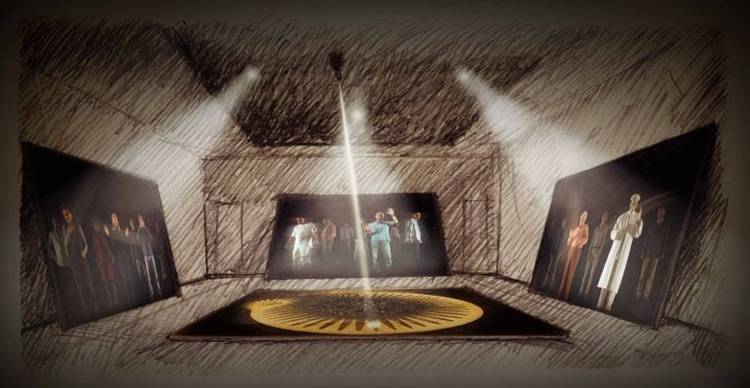


ROME - For the first time in the 110-year history of the Venice Biennale, open June 1 through Nov. 24, the sovereign state of the Vatican will have its own pavilion within the Arsenale. Its theme, "Creation, Un-Creation, Re-Creation," is intended as an illustration of the first eleven books of Genesis and also as modern homage to Michelangelo's five-centuries-old Sistine Chapel ceiling. Although the Vatican participated in the Biennale two years ago, it was as a neighboring outsider whose exhibition was presented inside a building belonging to the Church but outside the Arsenale area of Venice where the Biennale proper is held.
A reconciliation between the sacred and the profane in art has long been the goal of Cardinal Gianfranco Ravasi, head of the Pontifical Cultural Commission. Speaking at a press conference at the Vatican Tuesday, Ravasi explained that, "We are trying to reconstruct what has been essentially a divorce between art and faith. The fracture has existed; art went its own way, including with sometimes provocative and even blasphemous themes." In an interview for the New York monthly ARTnews some years ago the then Mons. Ravasi had expanded on this, adding that, whereas the new Roman Catholic churches are the works of the finest contemporary architects, their interior adornments fail to achieve the same artistic level.
The new Vatican pavilion, which has three separate spaces within the old Sala d'Armi of the Arsenale, features three radically different and, each in its way, novel works. The first, which represents the Creation, is by a three-man multi-media team called Studio Azzurro of Milan [2]. In the center of a dark room is a stone mass which can be touched by the visitor, who by his hand evokes sounds and images evoking the earliest phases of life in the animal and vegetable kingdoms. This interactive installation is in its way a development out of computer gaming, and akin to the Vatican Museum's new interactive installation in its Etruscan collection, called "Etruscanning."
Un-Creation, which can also be interpreted as chaos and man's inhumanity to man, is illustrated by dramatic scenes of war and devastation taken by the prize-winning Czech photographer Josef Koudelka [3], who was had countless international exhibitions and was recently featured in National Geographic magazine. The concept is of man's defiance of God's plan, Ravasi has explained. Koudelka's smuggled photographs of the brutality of Soviet tanks hurtling down the streets of Prague in 1968 were published throughout the West but could not be signed so as to protect his family in Czechoslovakia. He is also noted for his series of sensitive photos of the Rom (the people we once called Gypsies).
The third pavilion area is occupied by a one-man exhibition of works by an Australian-born artist who has worked for decades in the U.S., Lawrence Carroll [4]. His abstract illustrations of Re-Creation - that is, the search for hope - are built upon the concept that outgrown, castoff objects, such as an artist's canvass that has been thrown away and re-used by another, can imply the possibility of a new beginning and spiritual rebirth, as in Noah and his Arc. Carroll's works are in some of the collections of some of the world's most important museums, not least the LACMA in Los Angeles and the Guggenheim in New York. Interestingly, in 1994 Carroll participated in on exhibition in Koln, Germany, with Ugo Kittlemann, a German who is also present at the Biennale as the first non-Russian curator of the Russian pavilion.
An additional exhibition space is dedicated to three works by the late Tano Festa, who died in 1988, who made a series of works inspired by Michelangelo. Two by him had been exhibited at the Venice Biennale in l964.
Choosing representatives of contemporary art to present at the Biennale cannot have been easy for Ravasi and his advisors, who included Antonio Paolucci, director of the Vatican Museums, and Micol Forti, a member of the Pontifical commission. As Biennale president Paolo Barratta explained, with Ravasi nodding beside him, the works shown at the Biennale represent a moment of gestation and are not necessarily chosen "in view of their final destination." The Biennale is a "birthplace," Barratta emphasized, "reflecting the artists' sense of urgency."
A few Catholic bloggers protested in advance that the forthcoming exhibition would employ artists signed up, "not to represent Catholic spirituality, but to demonstrate that the lay artist too can acceed to the sacred." Another consideration was cost, and prior to the announcement of the trio of exhibits Catholic bloggers were already complaining of what they considered money they considered wasted on costly insurance, packaging and transport. In fact, the total cost of under $970,000 was paid by a group of sponsors. The largest single cost ($400,000 circa) was for rental and maintenance of the pavilion space.
In the end, the Church commission chose not to ask friendly artists to exhibit three Crucifixes or three Madonnas, although, said Ravasi, "We may do just that in the future." Several women artists were considered but, when invited to participate, were unable to do so; one, because the work proposed was too delicate to travel because it was composed of butterfly wings.
Source URL: http://440468.6bgr9ubv.asia/magazine/focus/art-culture/article/vatican-biennale-where-sacred-and-profane-art-meet
Links
[1] http://440468.6bgr9ubv.asia/files/01studioazzurro13688936221369214245jpg
[2] http://www.studioazzurrocom
[3] http://en.wikipedia.org/wiki/Josef_Koudelka
[4] http://en.wikipedia.org/wiki/Lawrence_Carroll